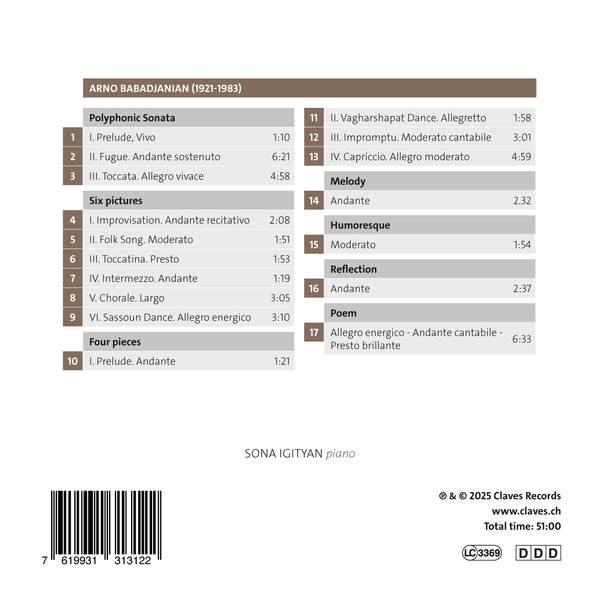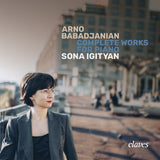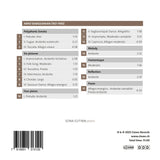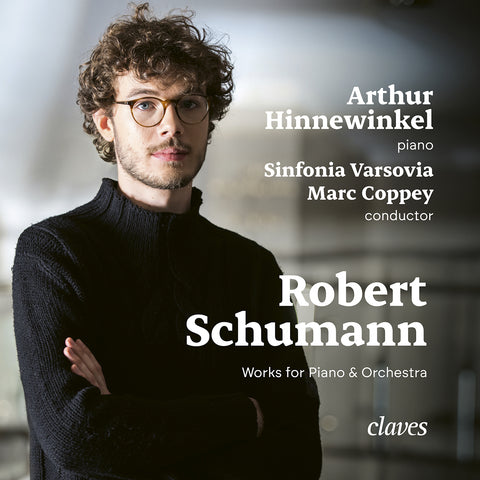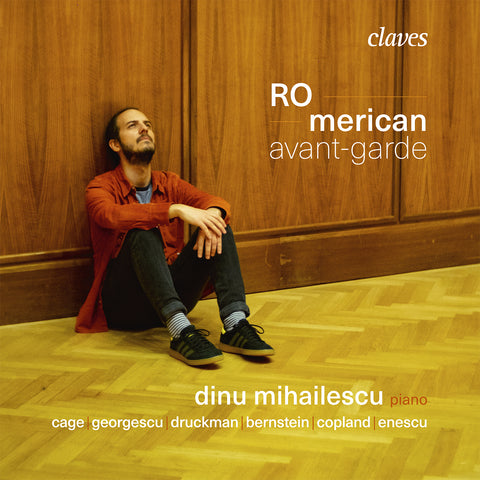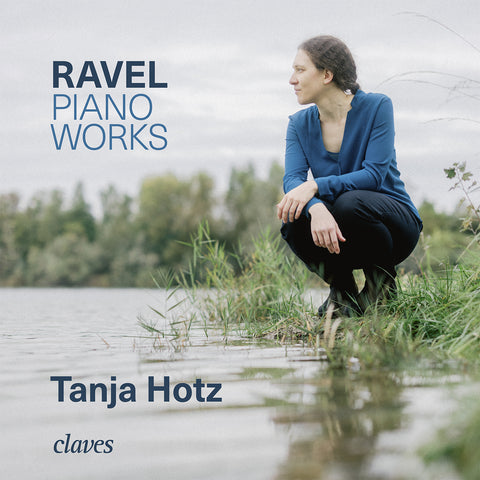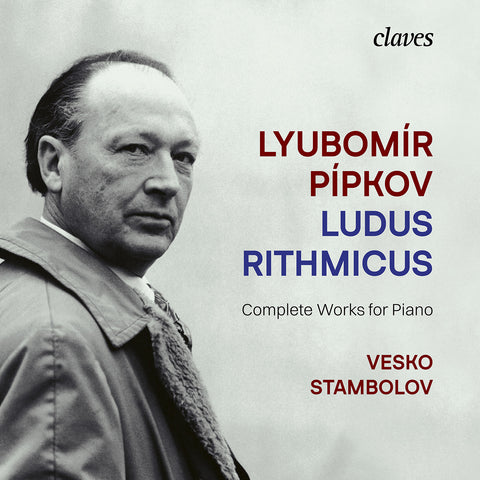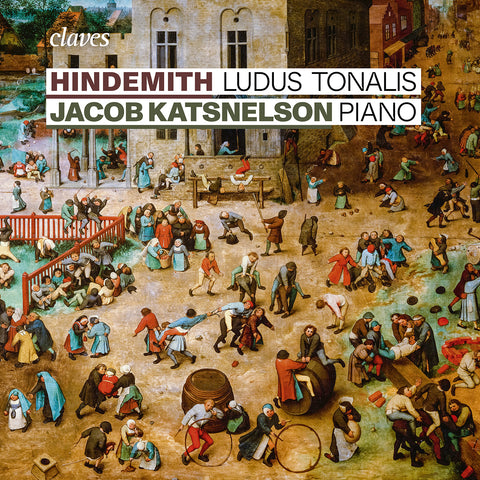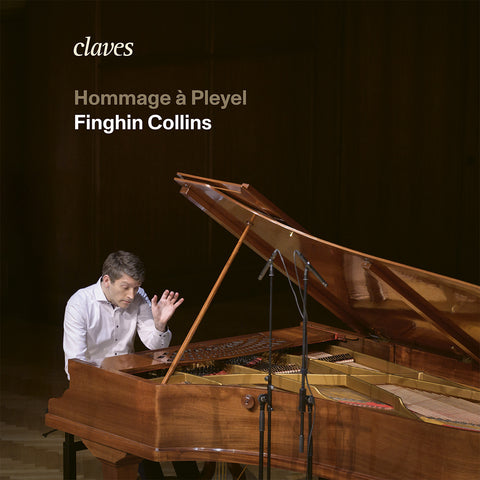(2025) Arno Babadjanian: Works for piano
Category(ies): Piano Rarities
Instrument(s): Piano
Main Composer: Arno Babadjanian
CD set: 1
Catalog N°:
CD 3131
Release: 26.09.2025
EAN/UPC: 7619931313122
This album is now on repressing. Pre-order it at a special price now.
CHF 18.50
This album is no longer available on CD.
This album has not been released yet. Pre-order it from now.
CHF 18.50
This album is no longer available on CD.
CHF 18.50
VAT included for Switzerland & UE
Free shipping
This album is no longer available on CD.
VAT included for Switzerland & UE
Free shipping
This album is now on repressing. Pre-order it at a special price now.
CHF 18.50
This album is no longer available on CD.
This album has not been released yet.
Pre-order it at a special price now.
CHF 18.50
This album is no longer available on CD.
CHF 18.50
This album is no longer available on CD.
ARNO BABADJANIAN: WORKS FOR PIANO
PIANO WORKS ARNO BABADJANIAN (1921–1983)
“Only musical ideas inspired by passion can truly move the listener,” wrote Arno Babadjanian. This Armenian pianist and composer followed a fascinating musical path at the crossroads of multiple influences. His work bridges folklore and popular music with all the major musical trends of the 20th century, from Bartók’s rhythmic writing to Schoenberg’s dodecaphonism, with jazz and even rock’n’roll leaving their mark.
Arno Babadjanian was born in Yerevan in 1921 and died in the same city in 1983 from leukemia. He showed musical aptitude from an early age. After entering the conservatory at age seven, he wrote his first composition, The Pioneers’ Waltz, just two years later. Gifted with an excellent memory and outstanding sight-reading skills, he studied with Armenian composer Sergei Barkhudaryan (1887–1972). Babadjanian then continued his training at the Moscow Conservatory in Konstantin Igumnov’s class (1873–1948), deepening his knowledge of Bach – whose counterpoint fascinated him – as well as Beethoven, Chopin, and Rachmaninoff. After graduating in both piano and composition in 1948, he returned to Armenia to take up a teaching position at the Yerevan Conservatory. His catalogue includes about twenty works for solo piano or two pianos, several chamber music pieces – including his famous Piano Trio in F-sharp minor, premiered in 1952 by violinist David Oistrakh, cellist Sviatoslav Knushevitsky, and the composer himself at the piano – and various orchestral works. Among them are the Poem-Rhapsody (1954), the piano concerto (1944), the violin concerto (1948), the cello concerto (1962), and the Heroic Ballad for piano and orchestra (1950). Babadjanian also composed for the theatre and ballet, wrote film music such as The Song of First Love (1958) and created songs infused with Armenian folklore.
The Polyphonic Sonata, written in 1946 and revised in 1956, is perhaps the composer’s most significant piano work. As pianist Sona Igityan pointed out, the piece is notable “for its technical and rhythmic complexity, as well as its polyphonic writing.”1 It opens with a quick Prelude, marked marcato, light and sparkling. This is followed by a Fugue: its haunting theme, embellished with trills, rises in heart-rending waves to a fortissimo (marked ffff in the score) before subsiding to a pianissimo2, with a staccato left hand in the lower register evoking a heartbeat that gradually comes to a halt. The piece reflects Babadjanian’s years of study under Khachaturian and the influence of Genrikh Litinsky, a contrapuntal master. The third movement, a rhythmic and marcato Toccata, brings back the playful and inventive spirit of baroque toccatas. It interweaves two themes that prove to be the same motive at different tempi, culminating in a dazzling sonic explosion.
Twenty years later, in 1964, Babadjanian composed the Six Pictures for Piano, revealing another source of inspiration and marking a milestone in Armenian music by blending folk inspiration with serial and atonal music. From the late 1950s onward, the composer had developed a keen interest in the Second Viennese School3. In these six miniatures, he enriched this language with his own stylistic hallmarks – nature, emotion, and the folk colour that permeates his work.
The cycle opens with an Improvisation reminiscent, in a completely different genre, of Louis Couperin’s unmeasured Préludes. Although everything is precisely notated in the score, the piece retains a sense of freedom. According to musicologist Svetlana Sarkisyan, the introduction recalls the principal theme of Schoenberg’s A Survivor from Warsaw4. The following piece, Folk Song, is full of fantasy and marked giocoso; it is built on dotted rhythms reminiscent of traditional folk dances, framing a lyrical interlude. American musicologist Nune Melikyan interpreted the Toccatina as an evocation of an “urban landscape filled with its endless machines and bustling factories.” Its aggressive minor sevenths and tritones indeed suggest the ceaseless motion of eternally running machines5. This is followed by an Intermezzo reminiscent of the first Image through its improvisatory character. Its dodecaphonic theme also recalls the Folk Song– the cycle thus builds through these echoes and mirror effects. The Intermezzo contrasts with the slow and meditative Chorale, built on an ostinato that creates a sense of calm and stillness. Its theme gradually intensifies, culminating in pianissimo before returning to its grave character. Finally, the Sassoun Dance closes the set with a traditional Armenian kochari, a round dance performed by groups of men. The piece is striking for its ever‑changing time signature: 5/8, 4/8, 7/8, 5/8, 4/8, 7/8, 3/8, 5/8, and so on. The city of Sassoun was one of the most important sites of the Great Armenian Empire (between 190 BC and 428 AD). It was also the last to resist the Ottoman Empire during the 1915 genocide, enduring a six‑month siege. Its military dances have become “symbols of bravery, heroism, and patriotism.”6 Once again, folklore meets serial language. While visiting Armenia in 1965, English composer Benjamin Britten attended a performance of the Six Pictures by the composer and was reportedly fascinated by the rhythmic construction of this final piece.
The Four Pieces were written at different stages of Babadjanian’s life, but the composer often performed them as a set in this specific order. As a result, they came to be regarded by audiences as a cycle of pieces based on Armenian folk themes. The Prelude (1943) in B‑flat minor develops an elegiac theme that soars like a call. In the parallel key of B‑flat major, the expansive Vagharshapat Dance (1943) combines a resolute pulse with a brilliant, lyrical, almost romantic theme. It is based on the song Yerangi (“nuances”) by Father Komitas (1869‑1935), the famous Armenian priest and musicologist who introduced Armenian culture to Western Europe. Composed a year later, the Impromptu in B minor follows the same melodic vein, evoking first women’s dances, then men’s dances. Finally, Arno Babadjanian composed in 1952 his Capriccio in D‑flat major, combining the sweeping, rhapsodic melodies of the previous pieces with a pulsing waltz rhythm and brilliant virtuosity.
The Melody is a long, nostalgic cantilena paired with the Humoresque; both were composed in 1970. The composer wrote these pieces for his son Ara at his teacher’s request. They are easy pieces intended for inclusion in music school examination programs. While the Andante recalls Rachmaninoff’s style, the Humoresque is a whimsical, humorous scherzo infused with jazz influences.
Although written in 1969, the piece titled Reflection was not published until 2006. This meditation, filled with atonality and dissonance, mirrors a contemplative yet troubled state of mind.
Finally, the Poem was composed for the Tchaikovsky Competition. For its 1966 edition, the Ministry of Culture commissioned a compulsory piece for the second round that would showcase all the instrument’s technical possibilities. Babadjanian’s Poem was selected from among twelve submissions. The piece is structured in two contrasting parts: an Andante cantabile is followed by a feverish and virtuosic Presto brillante. At its premiere, it received an enthusiastic reception from the audience.
Bénédicte Gandois
Translation: Michelle Bulloch – Musitext
"Energy, fervour, rich and seductive sound, superb groove, rare music to discover, impeccable sound recording, magnificent piano, well-chosen pieces; in short: well done!" - Patrick Peikert
- The author wishes to thank Sona Igityan for her comments on the work performed on this recording.
- Genrikh Litinsky is the author, for example, of Soviet Polyphonic Art (1954) and Polyphonic Exercises for the Composers (1965), and his article ‘Some Features of the Soviet School Composition’ established the modern Soviet school of counterpoint in 1986. Source: Nune Melikyan, Arno Babadjanian: an Armenian Composer in the Soviet Context, p. 23.
- Source: Svetlana Sarskisyan, Dedicated to Arno Babadjanian, Yerevan, Antares, 2008, p. 24, quoted by Nune Melikyan, op. cit..
- Svetlana Sarskisyan, 2011 article, p. 32, quoted by Nune Melikyan, op. cit..
- Nune Melikyan, op. cit., p. 57.
- Nune Melikyan, op. cit., p. 58.
SONA IGITYAN
Born into a family of artists, Sona Igityan started studying the piano when she was seven years old, at one of the best music schools in Yerevan, her hometown. She was lucky enough to become a student of an exceptional teacher, Venus Haroutunian. Thanks to her first teacher, Sona acquired a particularly deep and smooth sound as well as a supple piano technique. Three years later she gave a remarkable performance of Bach’s piano concerto in G minor with the National Chamber Orchestra of Armenia.
Sona was selected for broadcasting on National Radio at the age of twelve and won the prize for the best performance at the New Names Festival in Yerevan at the age of seventeen. Sona was advised by renowned teachers such as Willy Sarkissian in Armenia, Elisabeth Athanassova, Michel Kiener, Jean-Jacques Balet and Paul Coker in Switzerland and Paco Moya in Spain. She obtained her soloist and chamber music diplomas at Komitas State Conservatory in Yerevan in 1996 and at Haute École de Musique de Genève in 2007. At the age of 14 she began her concert career and since then has followed as a soloist and also as a chamber musician in different cities in Armenia, Germany, France, Netherlands, Spain and Switzerland.
In Switzerland she regularly plays in musical events such as Musique en été in the Old Town of Geneva, the Piano Festival Concertus Saisonnus, Festival du Jura, Fête de la Musique de Genève, 20heures de Musique in Romont, Geneva La Primaire gallery, PianoFest Moudon in Vaud. Sona Igityan’s repertoire includes different periods and styles, from baroque to contemporary music. Having a sound preference for modern music, she often ensures the performance of pieces by contemporary composers such as Ashot Zohrabian, Edouard Sadoyan, Karl Haydmayer and Shauna Beesly. Although Sona is interested in various forms of artistic expression such as theater, cinema and literature, the music is above all a kind of religion and tells the absolute truth.
REVIEWS
"Arno Babadjanian Armenien brachte bereits als Sowjetrepublik eine Vielzahl berühmter Musiker hervor. Nicht allzu bekannt blieb Arno Babadjanian (1921–1983), Pianist und Dozent sowie Komponist. Er schlug Brücken zwischen Bach und Neuer Musik, Folklore, Jazz und Filmmusik. Die Schweiz-Armenierin Sona Igityan hat nun all seine Werke für Solopiano eingespielt. Ein faszinierender Klangbogen von funkelnden Melodien bis zu rhythmisch vertrackten Suiten." - Frank von Niederhäusern, September 2025
"Après avoir révélé les inspirations bulgares de Lyubomír Pípkov ce printemps, le label Claves braque les projecteurs sur un autre compositeur du XXe siècle: Arno Babadjanian (1921-1983). La pianiste suisso-arménienne Sona Igityan, instigatrice du PianoFest à Moudon, s’est lancé le défi d’enregistrer l’intégrale pour piano solo de son compatriote. Défi remporté haut la main, à la hauteur de la virtuosité décapante exigée par cette musique à la croisée des styles. [..]" - Matthieu Chenal, septembre 2025
"Repéré enfant par Khatchaturian pour ses dons musicaux, Arno Babadjanian étudie la composition et le piano à Erevan puis à Moscou, où il a pour maîtres Chebaline et Igoumnov. Son langage se caractérise par une vitalité rythmique enlevée, des mélodies souvent teintées de folklore, et un emploi virtuose des timbres. [..]" - Bertrand Boissard, novembre 2025
"[..] D’un dynamisme percussif, la "Sonate Polyphonique" (1956) est rendue avec une pulsation intense sous les doigts de Sona Igityan. Impressionnante de vie, elle annonce l’étonnant mélange que procure l’écoute des "Six Images" (1964). Celles-ci associent réminiscences de folklores, musique sérielle et atonale. Le jeu très lyrique de l’interprète, sa précision dans la recherche et la définition des couleurs impressionne. Les "Quatre Pièces" datées des années trente et quarante sont davantage romantiques et d’une belle élégance élégiaque. Elles sont les plus abordables parce que les plus chantantes de la culture arménienne. Quatre autres partitions referment le disque : Elégie, Humoresque, Réflexion et Poème. Un peu de l’âme de Rachmaninov, d’orientalisme dissonant, d’esprit méditatif et, enfin, de bravoure (Poème fut destiné aux épreuves du Concours Tchaïkovski de 1956) referment un disque des plus intéressants et très bien défendu." - Bertrand Boissard, novembre 2025
"[..] This is an excellent programme that deserves a place in any good 20th century piano collection. Sona Igityan eats all of the virtuoso passages for breakfast, and the very fine recording captures every nuance of her playing and these fascinating works. [..]" - Dominy Clements, November 2025
(2025) Arno Babadjanian: Works for piano - CD 3131
PIANO WORKS ARNO BABADJANIAN (1921–1983)
“Only musical ideas inspired by passion can truly move the listener,” wrote Arno Babadjanian. This Armenian pianist and composer followed a fascinating musical path at the crossroads of multiple influences. His work bridges folklore and popular music with all the major musical trends of the 20th century, from Bartók’s rhythmic writing to Schoenberg’s dodecaphonism, with jazz and even rock’n’roll leaving their mark.
Arno Babadjanian was born in Yerevan in 1921 and died in the same city in 1983 from leukemia. He showed musical aptitude from an early age. After entering the conservatory at age seven, he wrote his first composition, The Pioneers’ Waltz, just two years later. Gifted with an excellent memory and outstanding sight-reading skills, he studied with Armenian composer Sergei Barkhudaryan (1887–1972). Babadjanian then continued his training at the Moscow Conservatory in Konstantin Igumnov’s class (1873–1948), deepening his knowledge of Bach – whose counterpoint fascinated him – as well as Beethoven, Chopin, and Rachmaninoff. After graduating in both piano and composition in 1948, he returned to Armenia to take up a teaching position at the Yerevan Conservatory. His catalogue includes about twenty works for solo piano or two pianos, several chamber music pieces – including his famous Piano Trio in F-sharp minor, premiered in 1952 by violinist David Oistrakh, cellist Sviatoslav Knushevitsky, and the composer himself at the piano – and various orchestral works. Among them are the Poem-Rhapsody (1954), the piano concerto (1944), the violin concerto (1948), the cello concerto (1962), and the Heroic Ballad for piano and orchestra (1950). Babadjanian also composed for the theatre and ballet, wrote film music such as The Song of First Love (1958) and created songs infused with Armenian folklore.
The Polyphonic Sonata, written in 1946 and revised in 1956, is perhaps the composer’s most significant piano work. As pianist Sona Igityan pointed out, the piece is notable “for its technical and rhythmic complexity, as well as its polyphonic writing.”1 It opens with a quick Prelude, marked marcato, light and sparkling. This is followed by a Fugue: its haunting theme, embellished with trills, rises in heart-rending waves to a fortissimo (marked ffff in the score) before subsiding to a pianissimo2, with a staccato left hand in the lower register evoking a heartbeat that gradually comes to a halt. The piece reflects Babadjanian’s years of study under Khachaturian and the influence of Genrikh Litinsky, a contrapuntal master. The third movement, a rhythmic and marcato Toccata, brings back the playful and inventive spirit of baroque toccatas. It interweaves two themes that prove to be the same motive at different tempi, culminating in a dazzling sonic explosion.
Twenty years later, in 1964, Babadjanian composed the Six Pictures for Piano, revealing another source of inspiration and marking a milestone in Armenian music by blending folk inspiration with serial and atonal music. From the late 1950s onward, the composer had developed a keen interest in the Second Viennese School3. In these six miniatures, he enriched this language with his own stylistic hallmarks – nature, emotion, and the folk colour that permeates his work.
The cycle opens with an Improvisation reminiscent, in a completely different genre, of Louis Couperin’s unmeasured Préludes. Although everything is precisely notated in the score, the piece retains a sense of freedom. According to musicologist Svetlana Sarkisyan, the introduction recalls the principal theme of Schoenberg’s A Survivor from Warsaw4. The following piece, Folk Song, is full of fantasy and marked giocoso; it is built on dotted rhythms reminiscent of traditional folk dances, framing a lyrical interlude. American musicologist Nune Melikyan interpreted the Toccatina as an evocation of an “urban landscape filled with its endless machines and bustling factories.” Its aggressive minor sevenths and tritones indeed suggest the ceaseless motion of eternally running machines5. This is followed by an Intermezzo reminiscent of the first Image through its improvisatory character. Its dodecaphonic theme also recalls the Folk Song– the cycle thus builds through these echoes and mirror effects. The Intermezzo contrasts with the slow and meditative Chorale, built on an ostinato that creates a sense of calm and stillness. Its theme gradually intensifies, culminating in pianissimo before returning to its grave character. Finally, the Sassoun Dance closes the set with a traditional Armenian kochari, a round dance performed by groups of men. The piece is striking for its ever‑changing time signature: 5/8, 4/8, 7/8, 5/8, 4/8, 7/8, 3/8, 5/8, and so on. The city of Sassoun was one of the most important sites of the Great Armenian Empire (between 190 BC and 428 AD). It was also the last to resist the Ottoman Empire during the 1915 genocide, enduring a six‑month siege. Its military dances have become “symbols of bravery, heroism, and patriotism.”6 Once again, folklore meets serial language. While visiting Armenia in 1965, English composer Benjamin Britten attended a performance of the Six Pictures by the composer and was reportedly fascinated by the rhythmic construction of this final piece.
The Four Pieces were written at different stages of Babadjanian’s life, but the composer often performed them as a set in this specific order. As a result, they came to be regarded by audiences as a cycle of pieces based on Armenian folk themes. The Prelude (1943) in B‑flat minor develops an elegiac theme that soars like a call. In the parallel key of B‑flat major, the expansive Vagharshapat Dance (1943) combines a resolute pulse with a brilliant, lyrical, almost romantic theme. It is based on the song Yerangi (“nuances”) by Father Komitas (1869‑1935), the famous Armenian priest and musicologist who introduced Armenian culture to Western Europe. Composed a year later, the Impromptu in B minor follows the same melodic vein, evoking first women’s dances, then men’s dances. Finally, Arno Babadjanian composed in 1952 his Capriccio in D‑flat major, combining the sweeping, rhapsodic melodies of the previous pieces with a pulsing waltz rhythm and brilliant virtuosity.
The Melody is a long, nostalgic cantilena paired with the Humoresque; both were composed in 1970. The composer wrote these pieces for his son Ara at his teacher’s request. They are easy pieces intended for inclusion in music school examination programs. While the Andante recalls Rachmaninoff’s style, the Humoresque is a whimsical, humorous scherzo infused with jazz influences.
Although written in 1969, the piece titled Reflection was not published until 2006. This meditation, filled with atonality and dissonance, mirrors a contemplative yet troubled state of mind.
Finally, the Poem was composed for the Tchaikovsky Competition. For its 1966 edition, the Ministry of Culture commissioned a compulsory piece for the second round that would showcase all the instrument’s technical possibilities. Babadjanian’s Poem was selected from among twelve submissions. The piece is structured in two contrasting parts: an Andante cantabile is followed by a feverish and virtuosic Presto brillante. At its premiere, it received an enthusiastic reception from the audience.
Bénédicte Gandois
Translation: Michelle Bulloch – Musitext
"Energy, fervour, rich and seductive sound, superb groove, rare music to discover, impeccable sound recording, magnificent piano, well-chosen pieces; in short: well done!" - Patrick Peikert
- The author wishes to thank Sona Igityan for her comments on the work performed on this recording.
- Genrikh Litinsky is the author, for example, of Soviet Polyphonic Art (1954) and Polyphonic Exercises for the Composers (1965), and his article ‘Some Features of the Soviet School Composition’ established the modern Soviet school of counterpoint in 1986. Source: Nune Melikyan, Arno Babadjanian: an Armenian Composer in the Soviet Context, p. 23.
- Source: Svetlana Sarskisyan, Dedicated to Arno Babadjanian, Yerevan, Antares, 2008, p. 24, quoted by Nune Melikyan, op. cit..
- Svetlana Sarskisyan, 2011 article, p. 32, quoted by Nune Melikyan, op. cit..
- Nune Melikyan, op. cit., p. 57.
- Nune Melikyan, op. cit., p. 58.
SONA IGITYAN
Born into a family of artists, Sona Igityan started studying the piano when she was seven years old, at one of the best music schools in Yerevan, her hometown. She was lucky enough to become a student of an exceptional teacher, Venus Haroutunian. Thanks to her first teacher, Sona acquired a particularly deep and smooth sound as well as a supple piano technique. Three years later she gave a remarkable performance of Bach’s piano concerto in G minor with the National Chamber Orchestra of Armenia.
Sona was selected for broadcasting on National Radio at the age of twelve and won the prize for the best performance at the New Names Festival in Yerevan at the age of seventeen. Sona was advised by renowned teachers such as Willy Sarkissian in Armenia, Elisabeth Athanassova, Michel Kiener, Jean-Jacques Balet and Paul Coker in Switzerland and Paco Moya in Spain. She obtained her soloist and chamber music diplomas at Komitas State Conservatory in Yerevan in 1996 and at Haute École de Musique de Genève in 2007. At the age of 14 she began her concert career and since then has followed as a soloist and also as a chamber musician in different cities in Armenia, Germany, France, Netherlands, Spain and Switzerland.
In Switzerland she regularly plays in musical events such as Musique en été in the Old Town of Geneva, the Piano Festival Concertus Saisonnus, Festival du Jura, Fête de la Musique de Genève, 20heures de Musique in Romont, Geneva La Primaire gallery, PianoFest Moudon in Vaud. Sona Igityan’s repertoire includes different periods and styles, from baroque to contemporary music. Having a sound preference for modern music, she often ensures the performance of pieces by contemporary composers such as Ashot Zohrabian, Edouard Sadoyan, Karl Haydmayer and Shauna Beesly. Although Sona is interested in various forms of artistic expression such as theater, cinema and literature, the music is above all a kind of religion and tells the absolute truth.
REVIEWS
"Arno Babadjanian Armenien brachte bereits als Sowjetrepublik eine Vielzahl berühmter Musiker hervor. Nicht allzu bekannt blieb Arno Babadjanian (1921–1983), Pianist und Dozent sowie Komponist. Er schlug Brücken zwischen Bach und Neuer Musik, Folklore, Jazz und Filmmusik. Die Schweiz-Armenierin Sona Igityan hat nun all seine Werke für Solopiano eingespielt. Ein faszinierender Klangbogen von funkelnden Melodien bis zu rhythmisch vertrackten Suiten." - Frank von Niederhäusern, September 2025
"Après avoir révélé les inspirations bulgares de Lyubomír Pípkov ce printemps, le label Claves braque les projecteurs sur un autre compositeur du XXe siècle: Arno Babadjanian (1921-1983). La pianiste suisso-arménienne Sona Igityan, instigatrice du PianoFest à Moudon, s’est lancé le défi d’enregistrer l’intégrale pour piano solo de son compatriote. Défi remporté haut la main, à la hauteur de la virtuosité décapante exigée par cette musique à la croisée des styles. [..]" - Matthieu Chenal, septembre 2025
"Repéré enfant par Khatchaturian pour ses dons musicaux, Arno Babadjanian étudie la composition et le piano à Erevan puis à Moscou, où il a pour maîtres Chebaline et Igoumnov. Son langage se caractérise par une vitalité rythmique enlevée, des mélodies souvent teintées de folklore, et un emploi virtuose des timbres. [..]" - Bertrand Boissard, novembre 2025
"[..] D’un dynamisme percussif, la "Sonate Polyphonique" (1956) est rendue avec une pulsation intense sous les doigts de Sona Igityan. Impressionnante de vie, elle annonce l’étonnant mélange que procure l’écoute des "Six Images" (1964). Celles-ci associent réminiscences de folklores, musique sérielle et atonale. Le jeu très lyrique de l’interprète, sa précision dans la recherche et la définition des couleurs impressionne. Les "Quatre Pièces" datées des années trente et quarante sont davantage romantiques et d’une belle élégance élégiaque. Elles sont les plus abordables parce que les plus chantantes de la culture arménienne. Quatre autres partitions referment le disque : Elégie, Humoresque, Réflexion et Poème. Un peu de l’âme de Rachmaninov, d’orientalisme dissonant, d’esprit méditatif et, enfin, de bravoure (Poème fut destiné aux épreuves du Concours Tchaïkovski de 1956) referment un disque des plus intéressants et très bien défendu." - Bertrand Boissard, novembre 2025
"[..] This is an excellent programme that deserves a place in any good 20th century piano collection. Sona Igityan eats all of the virtuoso passages for breakfast, and the very fine recording captures every nuance of her playing and these fascinating works. [..]" - Dominy Clements, November 2025
Return to the album | Read the booklet | Open online links | Composer(s): Arno Babadjanian | Main Artist: Sona Igityan












